The cling of bells and the click of hooves—the sound of some 1,200 sheep and 200 red goats—replaced the normal noise of cars, trucks, and motorcycles on Madrid’s streets on Sunday. The animals were accompanied by their owners and shepherds, along with friends and supporters wearing traditional dress, entertaining the crowds with the rare spectacle.
The annual march of merino sheep through the historic heart of the Spanish capital, the Transhumance Festival, is a protest disguised as folklore.
The shepherds had brought their sheep and goats down from the Leonese Mountains, some 500 kilometres north of Madrid, to reclaim their mediaeval right of passage through the metropolis and remind modern Spain that they are the bearers of a dying tradition with benefits not easily replaced.
Except for areas in the very north of Scandinavia, Spain is the only country in Europe that has preserved a meaningful degree of the practice of the long-distance herding of cattle, and, along with it, the needed transhumance routes. In Spain, these cross-country highways for animals, called cañadas, date back to the thirteenth century, designated by King Alfonso X, ‘Alfonso the Wise,’ in 1273.
In fact, the sheep and goat herders who walked through the gates of the city on Sunday, October 23rd, are members of the Concejo de la Mesta (the mesta council), a national guild of sheep herders created by the same king in 1273. Until modern times, it was one of the most important guilds in Spain and had its own office in the Spanish capital long before the skyscrapers of capitalism lined the Castellana—the wide thoroughfare of Madrid’s financial district which is also, incidentally, part of the mediaeval cañada that runs through the city.
“You have probably walked through more than one livestock route even if you do not know it,” Transhumancia y Naturaleza, one of the organisations that sponsored the event explains on its website. “Even stepping on the asphalt of Madrid, we can be crossing old paths along which cattle move, since one of the main transhumance routes of the peninsula crosses precisely the centre of the capital.”
These routes managed to be used and preserved for over 700 years but were on the verge of disappearing in the 1990s. In 1994, sheep herders protested in front of Spain’s parliament to claim their ancient rights and the passage of the Ley de Vias Pecuarias (the law of cattle routes), the protection of the cañadas, and the legal right to use them. The protest led, in 1997, to the now-annual event. Since then, Spain’s cañadas have also been declared part of Europe’s Intangible Cultural Heritage.
Last Sunday, the shepherds and their sheep moved north from the Casa del Campo to the City Hall. In a symbolic act, the herders paid the mayor the maravedis, an old Spanish coin, owed to the city for the use of its streets, an arrangement in force since 1418.
Despite its festive, symbolic nature, the event is still, in essence, a protest.
José Delgado, a sheep farmer from Palencia, told the Spanish newspaper ABC that “one day it is a show, but they are taking away our way of life.”
According to Transhumancia y Naturaleza, the cañadas are in poor condition, lacking sufficient areas for shepherds and animals to find water or camp, part of the plight of extensive cattle farmers that the organisation works to actively remedy and bring attention to. At the same time, a variety of pressures are squeezing extensive animal farming—and sheep farming, particularly—out of the modern market economy. Spain, for centuries the European powerhouse of merino wool production, has lost 10 million sheep in the last ten years, largely to forces of globalisation, mass manufacturing of synthetic fabrics, and the push for industrial farming.
Shepherds also carried signs reading, “Transhumance grazing, to preserve biodiversity and cool our planet,” and “Against fires and desertification,” to vindicate their wider social and ecological value.
The importance of extensive cattle farming came to the fore last summer following the forest fires that consumed over 100,000 hectares in Spain. For centuries, freely grazing goats, sheep, and cows have helped keep Spain’s arid forests clear of the dry underbrush that served as fuel for this year’s devastating fires.
“The flow of thousands of herds has shaped the landscape and the collective memory for generations, always to the rhythmic rhythm of the cowbells,” Transhumancia y Naturaleza also explains.
At least once a year, the sound is also a cry for justice.





